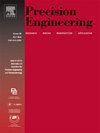Study on the wear mechanism of high-entropy alloy coated tools and grain evolution in micro-cutting of TC4 titanium alloy
IF 3.5
2区 工程技术
Q2 ENGINEERING, MANUFACTURING
Precision Engineering-Journal of the International Societies for Precision Engineering and Nanotechnology
Pub Date : 2024-12-26
DOI:10.1016/j.precisioneng.2024.12.010
引用次数: 0
Abstract
This study investigates the wear mechanisms and grain refinement patterns of CoCrFeNiAlX series high-entropy alloy-coated tools during the micro-cutting of TC4 titanium alloy. Three coatings were selected: CoCrFeNiAl (Al1), CoCrFeNiAl0.6 (Al0.6), and CoCrFeNi (Al0). Using DEFORM-3D for three-dimensional cutting simulations, the effects of coating type and thickness on tool wear and grain refinement in the cutting deformation zone were analyzed. Results show that at a coating thickness of 10 μm, all types of coated tools exhibited minimal wear depth. Al0.6 coating was significantly affected by thickness, with wear depth increasing by up to 10 %. Dual-layer coatings performed better in reducing wear and maintained good wear resistance even at higher thicknesses, whereas single-layer coatings showed a marked increase in wear depth and rate with increased thickness. As coating thickness increased, the number of dynamic recrystallization (DRX) grains at location P2 decreased for single-layer coated tools. Dual-layer coated tools showed stable DRX numbers, fluctuating between 400 and 600 at P2. Compared to single-layer coatings, dual-layer coatings exhibited higher DRX grain counts across all cutting deformation zones, especially in the third deformation zone, demonstrating superior mechanical properties and recrystallization effects. Dual-layer coated tools also displayed good stability with minimal grain size variation, with Al1 as the inner layer contributing to more stable grain sizes. The Al0.6+Al1 coating experienced significant grain size growth in the third deformation zone due to stress concentration.
求助全文
约1分钟内获得全文
求助全文
来源期刊
CiteScore
7.40
自引率
5.60%
发文量
177
审稿时长
46 days
期刊介绍:
Precision Engineering - Journal of the International Societies for Precision Engineering and Nanotechnology is devoted to the multidisciplinary study and practice of high accuracy engineering, metrology, and manufacturing. The journal takes an integrated approach to all subjects related to research, design, manufacture, performance validation, and application of high precision machines, instruments, and components, including fundamental and applied research and development in manufacturing processes, fabrication technology, and advanced measurement science. The scope includes precision-engineered systems and supporting metrology over the full range of length scales, from atom-based nanotechnology and advanced lithographic technology to large-scale systems, including optical and radio telescopes and macrometrology.

 求助内容:
求助内容: 应助结果提醒方式:
应助结果提醒方式:


